
Public transport in Tallinn
Encyclopedia
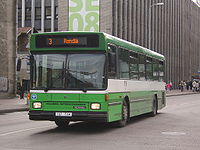
Bus
A bus is a road vehicle designed to carry passengers. Buses can have a capacity as high as 300 passengers. The most common type of bus is the single-decker bus, with larger loads carried by double-decker buses and articulated buses, and smaller loads carried by midibuses and minibuses; coaches are...
, tram
Tram
A tram is a passenger rail vehicle which runs on tracks along public urban streets and also sometimes on separate rights of way. It may also run between cities and/or towns , and/or partially grade separated even in the cities...
, trolleybus
Trolleybus
A trolleybus is an electric bus that draws its electricity from overhead wires using spring-loaded trolley poles. Two wires and poles are required to complete the electrical circuit...
, train
Train
A train is a connected series of vehicles for rail transport that move along a track to transport cargo or passengers from one place to another place. The track usually consists of two rails, but might also be a monorail or maglev guideway.Propulsion for the train is provided by a separate...
and ferry
Ferry
A ferry is a form of transportation, usually a boat, but sometimes a ship, used to carry primarily passengers, and sometimes vehicles and cargo as well, across a body of water. Most ferries operate on regular, frequent, return services...
services. Bus routes are mainly operated by Tallinna Autobussikoondis
Tallinna Autobussikoondis
Tallinna Autobussikoondis is the largest bus operator in Tallinn, Estonia.TAK was founded in 1945 as a state-owned company, under which status it operated until 1993, when it was reorganised as a public limited company owned by the City of Tallinn...
(TAK), but since 1995 MRP Linna Liinid is also operating some lines. All trams and trolleys are operated by Tallinna Trammi- ja Trollibussikoondis (TTTK). Electric train services are offered by Elektriraudtee and the ferry service to Aegna
Aegna
Aegna is an Estonian island in the Bay of Tallinn in the Baltic Sea. Administratively it is part of the city of Tallinn, the capital of Estonia and is a sub district of the Kesklinn district.-Geography:...
island is operated by Lindaliini AS under trademark "Linda Line".
Only buses, trams and trolleys belong to the unified ticket system, trains and ferries have their own ticket rates.
Today, Tallinn
Tallinn
Tallinn is the capital and largest city of Estonia. It occupies an area of with a population of 414,940. It is situated on the northern coast of the country, on the banks of the Gulf of Finland, south of Helsinki, east of Stockholm and west of Saint Petersburg. Tallinn's Old Town is in the list...
is the only city in Estonia ever to have trams or trolleybuses. The first tram route was opened in 1888 and in 2008, the tram celebrated its 120th anniversary. Trolleybuses were planned in Tallinn already in 1946, but the first route was opened 1965. Since then, 9 trolleybus routes have been opened, yet one was closed in 2000.
A light rail service in Tallinn has been planned since the 1970s. The project was stopped when Estonia became independent from the Soviet Union, but in the 2000s the planning has continued. The light rail would start in the city center, usually at Vabaduse väljak (Freedom Square
Freedom Square, Tallinn
Freedom Square is a plaza on the southern end of the Old Town in Tallinn, Estonia.It is bounded on the east by St. John's Church , on the south by Kaarli Boulevard and an underground shopping center , and on the west by a Victory Column commemorating the Estonian War of Independence 1918–1920.It...
) or Viru keskus (Viru shopping center) and finish in East Lasnamäe, having 10–12 stations.
All trains depart from the Balti jaam just at the northern end of Tallinn's Old City. Elektriraudtee offers local EMU
Electric multiple unit
An electric multiple unit or EMU is a multiple unit train consisting of self-propelled carriages, using electricity as the motive power. An EMU requires no separate locomotive, as electric traction motors are incorporated within one or a number of the carriages...
services to Keila
Keila
Keila is a town and an urban municipality in Harju County in north-western Estonia. It is also the administrative centre of the surrounding rural municipality – Keila Parish.-History:...
, Paldiski
Paldiski
Paldiski is a town and Baltic Sea port situated on the Pakri peninsula of north-western Estonia. Originally a Swedish settlement known as Rågervik, it became a Russian naval base in the 18th century. The Russians renamed it Балтийский Порт Paldiski is a town and Baltic Sea port situated on the...
and Riisipere
Riisipere
Riisipere is a small borough in the county of Harju, Estonia, and is the Nissi Parish administrative center. Located on the Ääsmäe-Haapsalu road, its distance from Tallinn is 45 km, from Haapsalu 50 km, Märjamaa 30 km, Rapla 40 km....
in the west and Aegviidu
Aegviidu
Aegviidu is a borough in northern Estonia. Administratively it constitutes Aegviidu Parish — a rural municipality within Harju County. The municipality has a population of 873 and covers an area of...
in the east. Edelaraudtee offers DMU
Diesel multiple unit
A diesel multiple unit or DMU is a multiple unit train consisting of multiple carriages powered by one or more on-board diesel engines. They may also be referred to as a railcar or railmotor, depending on country.-Design:...
services to Pärnu
Pärnu
Pärnu is a city in southwestern Estonia on the coast of Pärnu Bay, an inlet of the Gulf of Riga in the Baltic Sea. It is a popular summer vacation resort with many hotels, restaurants, and large beaches. The Pärnu River flows through the city and drains into the Gulf of Riga...
, Viljandi
Viljandi
Viljandi is a town and municipality in southern Estonia with a population of 19,150 . It is the capital of Viljandi County. The town was first mentioned in 1283, upon being granted its town charter by Wilhelm von Endorpe....
, Tartu
Tartu
Tartu is the second largest city of Estonia. In contrast to Estonia's political and financial capital Tallinn, Tartu is often considered the intellectual and cultural hub, especially since it is home to Estonia's oldest and most renowned university. Situated 186 km southeast of Tallinn, the...
and Narva
Narva
Narva is the third largest city in Estonia. It is located at the eastern extreme point of Estonia, by the Russian border, on the Narva River which drains Lake Peipus.-Early history:...
. Currently Elektriraudtee has fairly old trains, but they've promised to renew their whole trainpark in 2013.
Internal
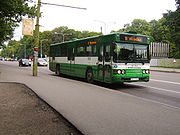
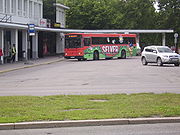
Pirita
Pirita is one of the eight administrative districts of Tallinn, the capital of Estonia. It had a population of 15,379 .Pirita occupies a relatively big area, but compared to other districts of Tallinn its population of 15,379 is relatively small...
, Lasnamäe
Lasnamäe
Lasnamäe is the most populous administrative district of Tallinn, the capital of Estonia. The districts' population is about 115,000, the majority of which is Russian-speaking. Local housing is mostly represented by 5-16 stories high panel blocks of flats, built in the 1970-1990s. Lasnamäe is...
and Nõmme
Nõmme
Nõmme is one of the 8 administrative districts of Tallinn, the capital of Estonia. It has a population of 38,168 and covers an area of , population density is...
they provide the backbone of the public transportation system, as these districts don't have trams or trolleybuses (except Nõmme, through which the Elektriraudtee western direction trains go).
The routes and timetables are set by Tallinna Transpordiamet (Tallinn Department of Transportation), but are given to either TAK or MRP to service. The contracts are renewed every 5 years.
The route numbers in Tallinn consist of one or two numbers, occasionally accompanied by a letter A or B. There has also been a special Park & Ride bus route 1PR, which was opened in September 2007 and offered service between the Pirita Park & Ride parking lot and the city center. The route was closed from January 2009.
Nearly all routes have two terminus stops, one of which serves to drivers also as a resting stop.
Tallinn doesn't have much "feeder lines", which take passengers to another means of transport. Currently, only bus route no. 57 has been shortened to a tram terminus.
Routes are mostly operated between 5:30 and 0:00 throughout the day. Some bus routes, mainly the express routes operate only during peak hours and have a break between 10–11 in the morning and 2–3 in the afternoon.
From November 7 until the end of 2008, the Department of Transport carried out a pilot project, during which popular bus and trolleybus routes' operating times were prolonged until 1 am.
Regional
Regional bus routes are managed by the Harjumaa Ühistranspordikeskus (HÜTK) (Harju County Public Transportation Center). The Center was established in early 2005. The establishers were the 25 local governments of Harjumaa and the Government of the Harju County as the representative of the Republic of Estonia. The goal of the center is to arrange public transportation in Harju County to raise quality of the service provided. The routes are drawn by HÜTK and then given to different operators. There are also about 50 commercial lines in Harju County.As of November 1, 2008, a zone system was introduced for public suburban routes. Harju County is divided to 4 zones, with the first one being Tallinn, second the surroundings of Tallinn and the rest are determined by the distance from Tallinn. Travelling within a zone will cost 12 EEK, and driving to another zone will cost an extra 10 EEK. The zone system replaces the current ticketing system, where the cost was determined by the distance driven - for example, if a route passes through a lot of villages instead taking a shortcut using the highway, the ticket would cost more.
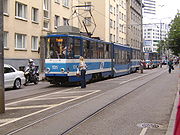
Tram
The tram network is fairly short and serves the city centre with its surrounding areas. There are 4 tram lines and two types of trams - Tatra KT4Tatra KT4
Tatra KT4 is the name of an articulated tramcar developed by the Czech firm ČKD Tatra. The first pre-production vehicles entered service in Potsdam in 1975, with the first production vehicles in 1977. A total of 1747 units were built, with initial deliveries to East Germany and later The USSR and...
and KT6, which basically is a KT4 with a lowered middle-section.
The tram system is operated by TTTK.
Trolleybus
Trolleybuses serve the western part of Tallinn, MustamäeMustamäe
Mustamäe is one of the 8 administrative districts of Tallinn, the capital of Estonia. The smallest by area , it is at the same time the second largest district by population with 64,450 inhabitants ....
and Haabersti
Haabersti
Haabersti is one of the 8 administrative districts of Tallinn, the capital of Estonia.It has a population of 41,388 .The most populous part of the district is Väike-Õismäe, a residential area consisting of the big panel houses, which were mostly built in the seventies...
districts especially. Trolleybus service began in 1965 with a route from the Estonian National Opera "Estonia" to Hipodroom (Hippodrome). Currently there are 8 routes: 1 - 5 from city center to Mustamäe, 6 and 7 to Õismäe and 9 from Mustamäe to Kopli
Kopli
Kopli is a subdistrict of the district of Põhja-Tallinn in Tallinn, the capital of Estonia. It has a population of 7,405...
.
Commuter train
The Elektriraudtee commuter trains are especially meant for the Harju County residents for a connection to Tallinn. The western routes are also used by the Nõmme district residents. Many people dislike the trains because of the noise they make. Elektriraudtee has promised to renew the fleet by 2013.Ferry
Tallinn has a ferry connection to AegnaAegna
Aegna is an Estonian island in the Bay of Tallinn in the Baltic Sea. Administratively it is part of the city of Tallinn, the capital of Estonia and is a sub district of the Kesklinn district.-Geography:...
island, operated by Lindaliini AS. Since Aegna doesn't have many residents, the ferry is mostly for tourists and is operated only summertime.
Tickets
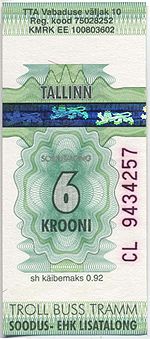
Ticket types
The transport system offers a vast number of different tickets and several ways to get them.Single tickets (talong) can be bought from vehicle drivers, kiosks or by a text message.
Those residents of Tallinn, who use public transport daily, usually have a 30- or 90-day period card. The tickets are loaded on the identification card (ID-kaart).
Ticket prices
| Ticket Name | Tallinn | |
|---|---|---|
| SINGLE TICKETS | Adult | Child |
| Single ticket | 0.96 € Euro The euro is the official currency of the eurozone: 17 of the 27 member states of the European Union. It is also the currency used by the Institutions of the European Union. The eurozone consists of Austria, Belgium, Cyprus, Estonia, Finland, France, Germany, Greece, Ireland, Italy, Luxembourg,... |
0.40 € |
| Single ticket from driver | 1.60 € | 0.80 € |
| Period tickets | Adult | Child |
| 30-day ID ticket | 18.53 € | 6.71 € |
| 90-day ID ticket | 42.18 € | 18.53 € |
Ticket prices above are for Tallinn residents; non-resident fares are higher.
All ticket prices can be found at the Tallinn.ee website.
Persons aged between 7 and 21 are eligible to use the lower priced child tickets. Anyone under the age of 7 may ride for free.

